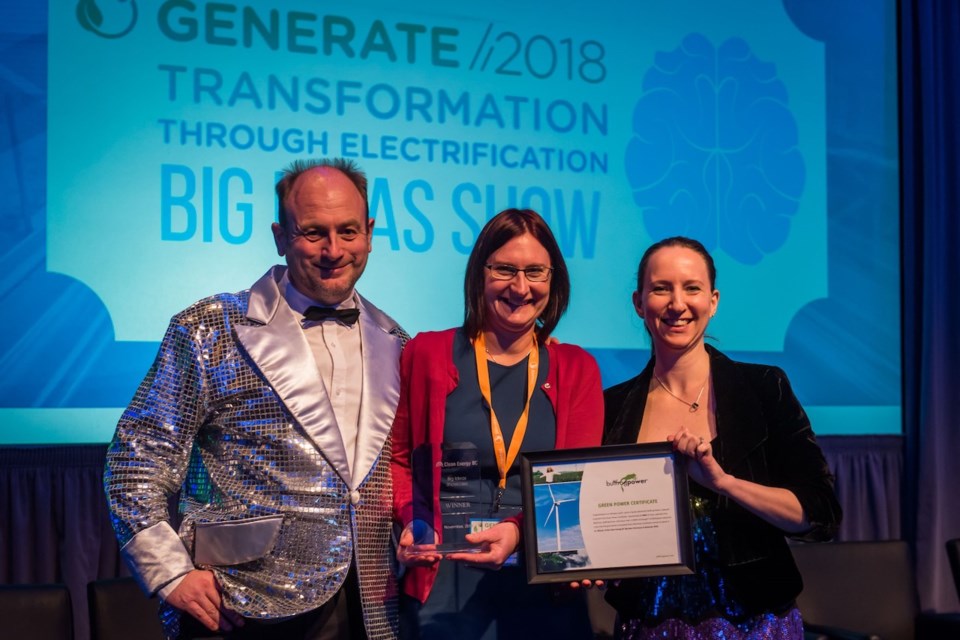At the Clean Energy BC annual conference in November, former municipal councillor Melanie Mason competed in a sort of ideas game show. The challenge was to present a clean energy generation idea to a crowd of industry members and have the crowd choose a favourite. The winning proposal? To make the Bowen ferry fully electric.
While this might seem like small project in the shadow of a massive problem, Mason argues that electrifying the Queen of Capilano would significantly reduce Bowen’s greenhouse gas footprint. The Bowen ferry run makes up 25 per cent of Bowen’s total greenhouse gas emissions.
“We can’t do anything to become a more sustainable community until we tackle transportation,” said Mason, who is also a member of Bowen’s Ferry Advisory Committee and the Bowen Island Municipality Transportation Advisory Committee (BIMTAC.)
“There’s an initiative underway to make Howe Sound a UNESCO biosphere region, we’re cleaning up the waters, we’ve got all these orcas coming in, clean tech would be good,” said Mason. “People are coming here for the natural beauty, however we’re all getting there by diesel.”
The case
Mason argued that with a ferry like the Norwegian Ampere, the world’s first fully electric car ferry, launched into service in 2015, there’s the potential to eliminate 90 to 95 per cent of the ferry’s emissions.
The Ampere’s run is similar to Bowen’s. It’s a 20-minute ride through a semi-protected fjord between Lavik and Oppedal, Norway, with a few hundred passengers per run.
In the case of the Ampere, Mason says that the new ferry saw operating costs cut by 80 per cent with a return on investment of at least 25 per cent per year (basically she says it pays for itself within four years.) The ferry is lighter and doesn’t require fuel. Though an e-ferry requires infrastructure, most notably the electrical capability and charging stations, Horseshoe Bay is to go through a $250 million upgrade in the early-to-mid 2020s.
For Jae Mather, fellow Bowener and executive director of Clean Energy BC, which promotes private-industry clean energy development and hosted the conference at which Mason presented her idea, it is time to act.
“Based on how long it takes to get grid connection studies with BC Hydro and upgrade grid connections, that could easily take three years on its own,” said Mather. “Now is the time to start incorporating this into the planning.”
The Ampere is also nearly silent, which means less disturbance for marine life and for humans living near ferry routes.
The energy storage technology for the Ampere comes out of Richmond’s Corvus Energy. The now world-renowned company mainly exports to Europe and Asia but is getting more recognition back home. Seaspan Ferries has incorporated this technology into two of its vessels and two e-ferries are bound for Ontario in 2020 and 2021.
“It’s a mature technology,” said Mason, addressing the frequent “wait and see” government approach.
“The challenges that exist with electrifying the Queen of Capilano are largely secondary. So they aren’t about money and they also are not about viability of the technology,” said Mather. “The challenges lie in getting decision makers at the top end within BC Ferries to press go.”
Mather says that this e-plan could work for either retrofitting the Queen of Capilano or a new ferry.
B.C. Ferries isn’t ignoring the push for clean technologies. It is building three new LNG-hybrid ships and converting one of its largest vessels (a Spirit class ship) to dual fuel next year. It’s also in talks to build eight smaller diesel-electric hybrid vessels through Corvus, but e-ferry proponents say that the emission reduction for hybrids is merely 20 per cent.
In press coverage of the idea of e-ferries, B.C. Ferries hasn’t embraced full conversion anytime soon. Mark Wilson, a vice-president for the organization, told CBC back in May that its ferries need to work on longer and shorter routes around the province, making the infrastructure requirements of battery-operated ships difficult to manage.
In the provincial climate change plan released last week, Clean BC (not to be mistaken with Clean Energy BC,) the government commits to e-ferries in the long run.
“For our inland ferry fleet, the future is electric,” it reads. “We aim to achieve full electrification of the inland ferry fleet by 2040.”
Mather says that’s not a good enough commitment.
“Why are we waiting 21 years to do things that are already here, that have short payback periods?” said Mather. “The problem with 2040 targets is motivating anybody to do anything. Even 2030 targets are hard to motivate people to do things now and change behavior now and invest now.
“A big chunk of the Clean BC climate plan is about fuel swap, so taking a fossil fuel and making it less. That that approach will only get you so far when there are technologies available that mean we can do a giant leap,” he said. “Otherwise we’re going to be here again in 15 years looking at doing exactly the same thing.
“Putting it simply, if B.C. has a target in 2030 to have a 40 percent reduction [in greenhouse gas emissions], electrifying the Queen of Capilano will effectively deliver that reduction for Bowen,” said Mather.
On the council side
Coincidentally, another islander was at the Clean Energy BC conference, local low-carbon economy advocate James Glave emceed the ideas game show Mason won.
Glave presented the e-ferry idea to municipal council Dec. 10.
“We wouldn’t be taking a huge risk with this, Norway has already done that for us,” he told council.
Councillors David Hocking and Sue Ellen Fast were enthusiastic, Hocking reiterating the need for climate action.
“By 2050 it has to be zero carbon,” said Hocking.
Councillor Maureen Nicholson suggested that Bowen invite BC Ferries’ president and CEO, Mark Collins, to visit the island and council to discuss electrification, to which there was general council agreement.



